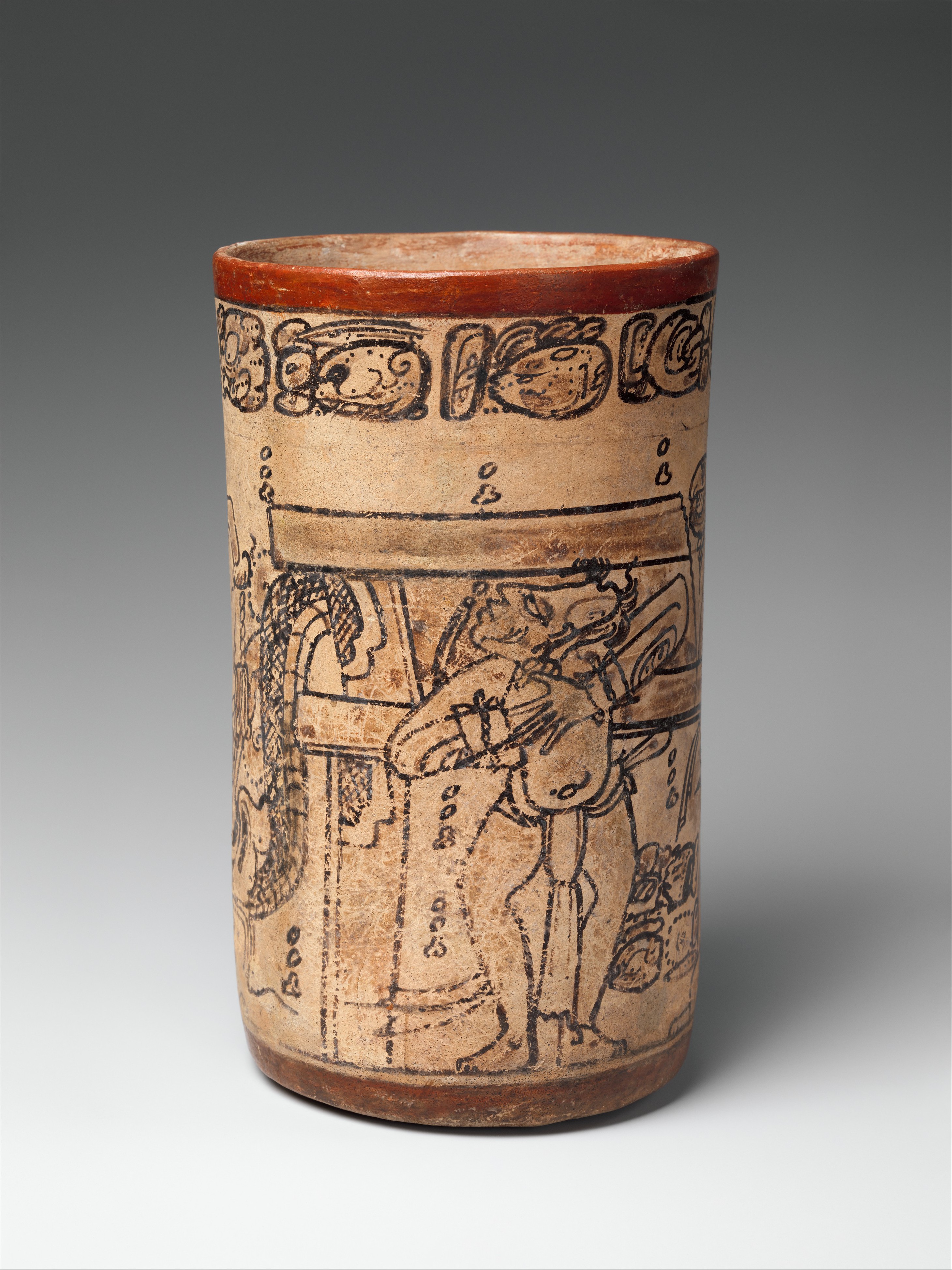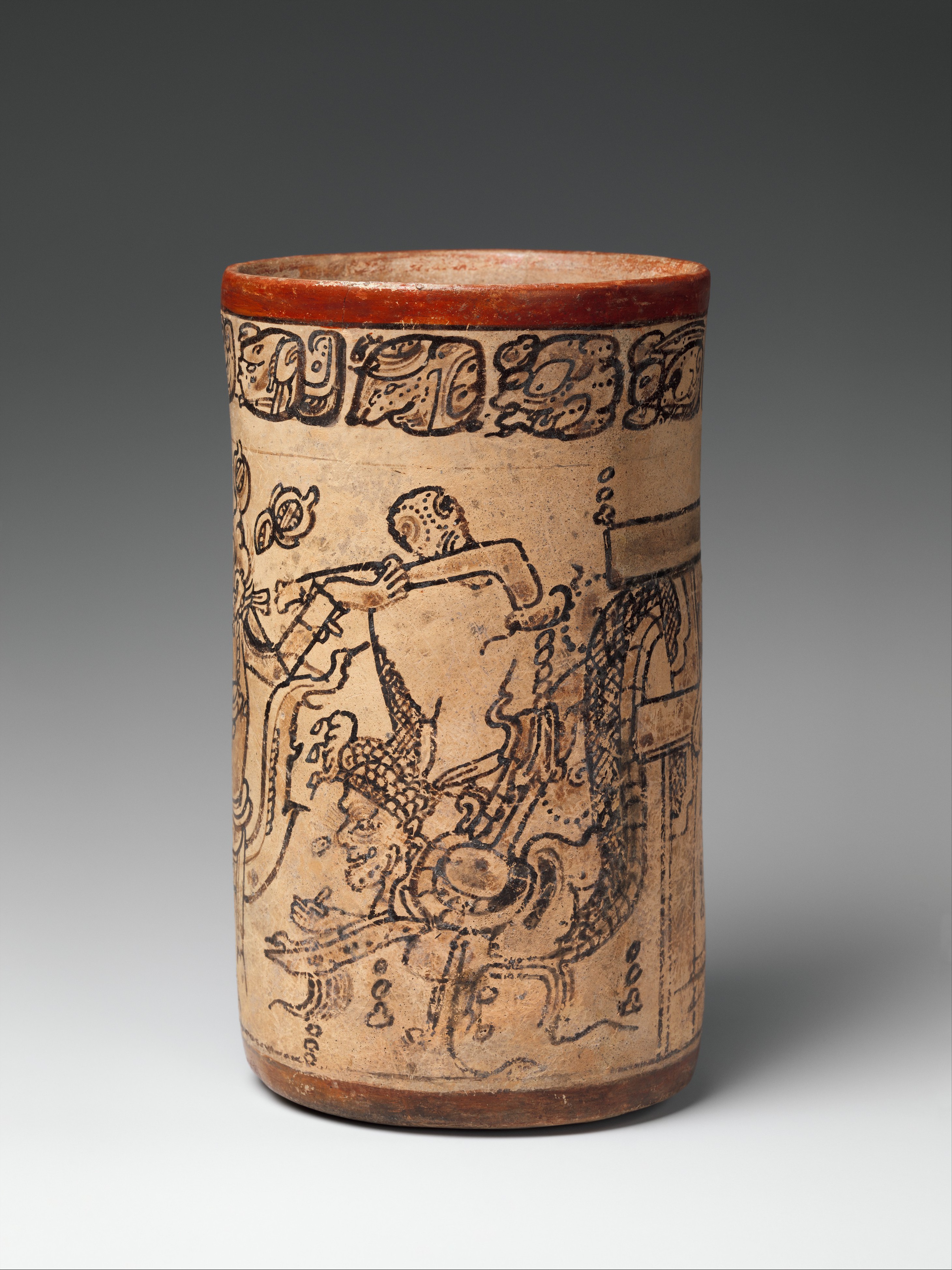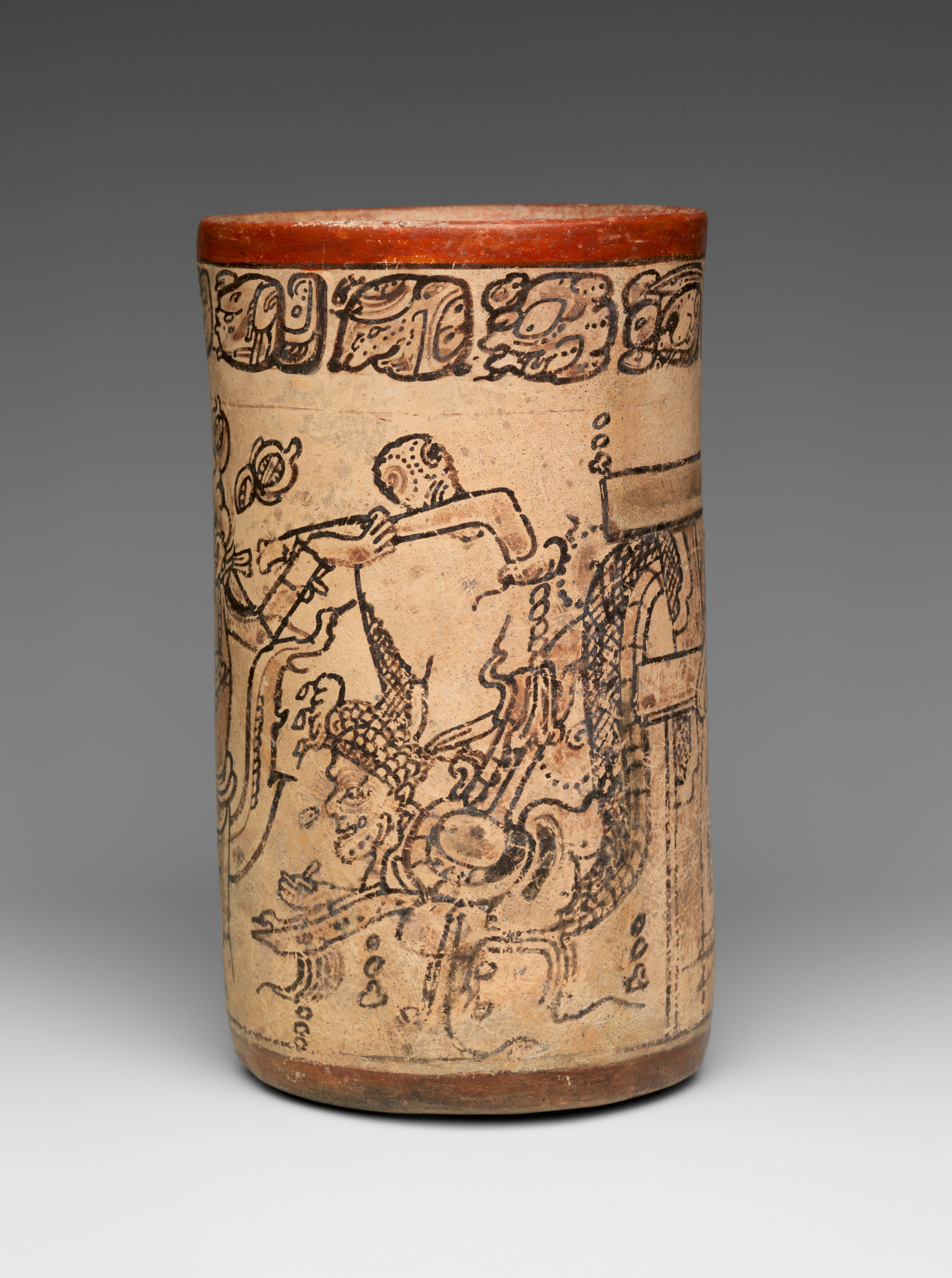Vessel with mythological scene
Not on view
This drinking cup, painted in what is known as the codex style, shows a unique scene from the corpus of Maya ceramic paintings. The protagonist is an aging Rain God, known by the name Chahk in the hieroglyphic script, who wields a ceremonial ax in his left hand while placing his right hand on a stone temple or palace that he has presumably split open. The “grape-bunch” motif located to the right of the cleft on the temple’s facade signifies that the building is made of stone, and four half-quatrefoil motifs marked with crosshatching perhaps represent windows in the walls.
Chahk is shown with features that appear in other depictions: a watery vegetation headdress, Spondylus earspools, and fishlike barbels. The tiny wisps of hair on the knob of his head, however, are nothing like the bushy, unruly tangle of knotted hair seen in his other portrayals (see MMA 1978.412.206; 1980.213). The torso of the god is also uncharacteristically saggy, accented with skin rolls— a convention in Maya artists’ depictions of geriatric bodies. A rather plain loincloth and trilobed pectoral contrast with the more elaborate dress and jewelry seen in other representations. Most peculiar here is the volute of vegetal smoke that the god vomits out. The spewed matter flows between his legs and upward, so that he appears to be seated in the crook of the watery emanation. Rather than dancing, he crouches.
Though Chahk is the largest character in the scene, the action seems to center on the two figures seen in front of the cracking temple. The one on the left, a youthful Maize God, identified by his cob-shaped head with wispy tassel hair and the shining hieroglyphs on his arms, poses as if in mid-dance. To his left sits a forlorn captive with black face paint and arms bound behind his back. The text to the left of the captive may identify him perhaps as a nighttime version of the same Maize God, but the phrasing is difficult to interpret. A dark mythological serpent emerges from one of the quatrefoil voids, and an aged god emerges from the serpent’s mouth.
The direction of the figures’ gazes reveals the sequence of events. The old god emerging from the serpent stares at the back of the aggressive Rain God, who in turn focuses intently on the building he is presumably destroying. In contrast, both the Maize God and the captive look upward. Scattered about the scene are circles and teardrop shapes aligned vertically in twos and threes. These likely represent raindrops falling as a result of Chahk’s ritual actions. Looking skyward, the Maize God and captive are awaiting the first rains, blessed for their life-giving powers but cursed for their destructive ability. By breaking open the building’s roof, Chahk could be bringing the Maize God back to life.
The text, which runs beneath the entire length of the upper band, refers to the “raising” of the “drinking cup” in an act of dedication. The vessel’s owner is noted as “striker” (ja-JATZ’-ma, jatz’oom), a name perhaps relating him to the ax-wielding figure of Chahk. The designation could also indicate the owner’s earthly role in the perpetuation of agricultural cycles—that of breaking open the soil to sow maize. The contrasts between good and evil, growth and decay, and the shine of youth versus the sag of old age converge in this mythic scene encapsulating the relationship between rain and maize.
Further reading
Bassie-Sweet, Karen. Maya Sacred Geography and the Creator Deities. Norman, University of Oklahoma Press, 2008, p. 146-147.
Boot, Erik What Happened on the Date 7 Manik’ 5 Who? An Analysis of Text and Image on Kerr Nos. 0717, 7447, and 8457. Wayeb Notes 21, 2006, p. 3. Available Online.
Braakhuis, H.E.M. The Tonsured Maize God and Chicome-Xochitl as Maize Bringers and Culture Heroes: A Gulf Coast Perspective. Wayeb Notes No. 32, 2009, Fig. 5. Available Online.
Carrasco, Michael David. The Mask Flange Iconographic Complex: The Art, Ritual, and History of a Maya Sacred Image. Unpublished Ph.D. Dissertation. Department of Art History, University of Texas at Austin, 2005, p. 456; Fig. B.7. Available Online
Carrasco, Michael David, and Kerry Hull. The Cosmogonic Symbolism of the Corbeled Vault in Maya Architecture. Mexicon XXIV (2002): 26-32.p. 27; Fig. 5.
Coe, Michael, and Justin Kerr The Art of the Maya Scribe. New York, Harry N. Abrams, 1998, p. 156-157; Fig. 127.
Doyle, James A. Creation Narratives on Ancient Maya Codex-Style Ceramics in the Met’s Collections. Metropolitan Museum Journal, vol. 51, 2016, pp. 42-63. Available Online.
García Barrios, Ana Chaahk, el dios de la lluvia, en el periodo Clásico maya: Aspectos religiosos y políticos. Unpublished Ph.D. Dissertation, Department of the Anthropology of America, Universidad Complutense de Madrid, 2008, p. 80-81, Fig. 1.63.
Grube, Nikolai, and Werner Nahm A Census of Xibalba: A Complete Inventory of Way Characters on Maya Ceramics. In The Maya Vase Book Vol. 4, eds. Barbara Kerr and Justin Kerr, pp. 686-715. New York, Kerr Associates, 1994, p. 688.
Houston, Stephen, David Stuart, and Karl Taube The Memory of Bones: Body, Being, and Experience among the Classic Maya. Austin, University of Texas Press, 2006, p. 49 Fig. 1.52 (a).
Kerr, Justin The Maya Vase Book: Volume 2. New York, Kerr Associates, 1990, p. 211.
Knowlton, Timothy The Stone-in-Hand Glyph, Foundation for the Advancement of Mesoamerican Studies, 1999. Available Online
Mora-Marin, David The Structure of the Dedicatory Formula in Classic Lowland Mayan Texts: A Preliminary Typology, 1999, p. 28. Available Online
Schoenmakers, Paul. Drawing, After Rollout of Vase Kerr 2068. Wayeb Drawing Archive, 2008. Available Online
Zender, Marc Glyphs for "Handspan" and "Strike" in Classic Maya Ballgame Texts. The PARI Journal 4(4):1-9, 2004, Fig 6, p. 5. Available Online
Due to rights restrictions, this image cannot be enlarged, viewed at full screen, or downloaded.
This artwork is meant to be viewed from right to left. Scroll left to view more.










